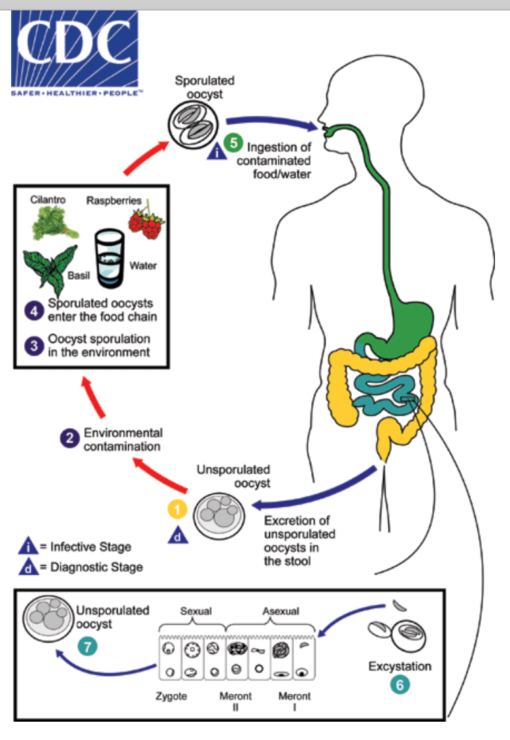The number of patients in a nationwide outbreak of infections from the foodborne Cyclospora parasite continue to increase, having reached 210 laboratory-confirmed cases.
Federal, state and local public health officials are investigating the outbreak, which is spread across 22 states and New York City, according to a June 22 update from the Centers for Disease Control and Prevention.
The CDC and the Food and Drug Administration have been tracking the outbreak since April 1. Additional infections could have started before that date.
Also, there are likely more than 210 people in the ongoing outbreak because of the lag time between when patients become ill and when confirmation testing can be completed and results filed with the CDC. Some sick people don’t seek medical attention, also impacting the outbreak count. The parasite is killed by using antibiotics. Specific tests are required to diagnose Cyclospora infections.
“No specific food items have been identified as the source of most of these illnesses. State and local public health officials are interviewing people with cyclosporiasis to find out what foods they ate before getting sick,” the CDC reported.

Cyclospora infections are frequently associated with produce in other countries, but none of the 210 confirmed patients reported international travel before becoming ill. In the past, some U.S. outbreaks have been traced to cilantro, basil, mesclun lettuce, raspberries and snow peas.
Food safety experts say there’s no evidence that washing produce will remove the parasite.
Sick people in the ongoing nationwide outbreak range in age from 3 to 95 years, with a median age of 49. Sixty-four percent of the patients are female. The median illness onset date is May 5, 2023, with a range of April 1 to June 9. Of 207 people with information available, 30 have been hospitalized. No deaths have been reported.
The total number of laboratory-confirmed cases reported since April 1 includes 20 patients in Georgia and Alabama linked to an outbreak associated with raw imported broccoli. Although FDA and state and local partners conducted traceback investigations, there was not enough information to identify a specific type or producer of the broccoli. No recall was conducted. As with the nationwide outbreak, there are likely more than 20 patients associated with the broccoli outbreak, according to the CDC.
The Georgia/Alabama outbreak linked to fresh broccoli appears to be over, according to the CDC and FDA. The two states continue to report other cases of Cyclospora infection not related to broccoli.
Cyclosporiasis illnesses are reported year-round in the United States. However, during the spring and summer months there is often an increase in cyclosporiasis acquired in the United States. The exact timing and duration of these seasonal increases can vary, but reports tend to increase starting in May. This year, cases were reported starting in April. It is too soon to tell if this timing indicates a change in the seasonality of cyclosporiasis in the United States, according to the CDC.
“Multiple outbreaks of cyclosporiasis caused by different foods can be reported during the same year. However, many cases of cyclosporiasis cannot be directly linked to an outbreak. Officials use questionnaires to interview sick people to determine what they ate in the 14-day period before getting sick. If a common food is found, CDC and partners work quickly to determine if the contaminated food is still available in stores or in peoples’ homes and issue advisories.”
About Cyclospora infections
Anyone who has developed symptoms of Cyclospora infection, and has reason to believe they have been exposed to the parasite, should seek medical attention. Specific tests are required and antibiotics are used to fight the parasite. Cyclospora infections can mimic other illnesses.
Cyclospora infection can cause severe abdominal pain, watery diarrhea, nausea, vomiting, body aches, and fatigue. Symptoms can develop between two and 14 days after exposure. Though symptoms can be severe enough to send people to the hospital, it’s rare for people to die from Cyclospora infections.
Cyclospora is a type of protozoa, which is a tiny, single-celled organism. It is transmitted when people somehow ingest contaminated feces — usually in microscopic amounts and typically through contaminated food or water. It can be spread only through human waste, unlike E. coli and salmonella, which can also be spread from animal fecal matter.
(To sign up for a free subscription to Food Safety News,click here)